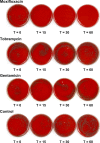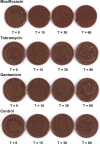Kinetics of kill of bacterial conjunctivitis isolates with moxifloxacin, a fluoroquinolone, compared with the aminoglycosides tobramycin and gentamicin
- PMID: 20169048
- PMCID: PMC2819768
- DOI: 10.2147/opth.s9244
Kinetics of kill of bacterial conjunctivitis isolates with moxifloxacin, a fluoroquinolone, compared with the aminoglycosides tobramycin and gentamicin
Abstract
Purpose: To compare the kinetics and speed of kill of Streptococcus pneumoniae and Haemophilus influenzae on exposure to three topical ophthalmic antibiotic solutions.
Materials and methods: Bacterial conjunctivitis isolates of S. pneumoniae and H. influenzae were exposed to 1:1000 dilutions of moxifloxacin 0.5%, tobramycin 0.3%, gentamicin 0.3%, and water (control). At 15, 30, 60, 120, and 180 minutes after exposure, aliquots were collected, cells were cultured, and viable cell counts were determined using standard microbiological methods.
Results: Moxifloxacin achieved 99.9% kill (3-log reduction) at approximately 2 hours for S. pneumoniae and at 15 minutes for H. influenzae. Tobramycin and gentamicin did not achieve 3-log reduction of S. pneumoniae during the 180-minute study period. An increase in bacterial growth was noted for these isolates. Gentamicin took more than 120 minutes to achieve the 3-log reduction of H. influenzae and tobramycin did not reach the 3-log reduction of this pathogen during the 180-minute study period.
Conclusion: Moxifloxacin killed S. pneumoniae and H. influenzae in vitro faster than tobramycin and gentamicin, suggesting its potential clinical benefit as a first-line treatment for bacterial conjunctivitis to minimize patient symptoms and to limit the contagiousness of the disease.
Keywords: Haemophilus influenzae; Streptococcus pneumoniae; aminoglycosides; bacterial conjunctivitis; fluoroquinolones; in vitro; kinetics of kill.
Figures




References
-
- Gigliotti F, Williams WT, Hayden FG, Hendley JO, Benjamin J, Dickens M, et al. Etiology of acute conjunctivitis in children. J Pediatr. 1981;98(4):531–536. - PubMed
-
- Weiss A, Brinser JH, Nazar-Stewart V. Acute conjunctivitis in childhood. J Pediatr. 1993;122(1):10–14. - PubMed
-
- Rose PW, Harnden A, Brueggemann AB, Perera R, Sheikh A, Crook D, et al. Chloramphenicol treatment for acute infective conjunctivitis in children in primary care: a randomised double-blind placebo-controlled trial. Lancet. 2005;66(9479):37–43. - PubMed
-
- Lichtenstein SJ, Dorfman M, Kennedy R, Stroman D. Controlling contagious bacterial conjunctivitis. J Pediatr Ophthalmol Strabismus. 2006;43(1):19–26. - PubMed
-
- Granet DB, Dorfman M, Stroman D, Cockrum P. A multicenter comparison of polymyxin B sulfate/trimethoprim ophthalmic solution and moxifloxacin in the speed of clinical efficacy for the treatment of bacterial conjunctivitis. J Pediatr Ophthalmol Strabismus. 2008;45(6):340–349. - PubMed
LinkOut - more resources
Full Text Sources

